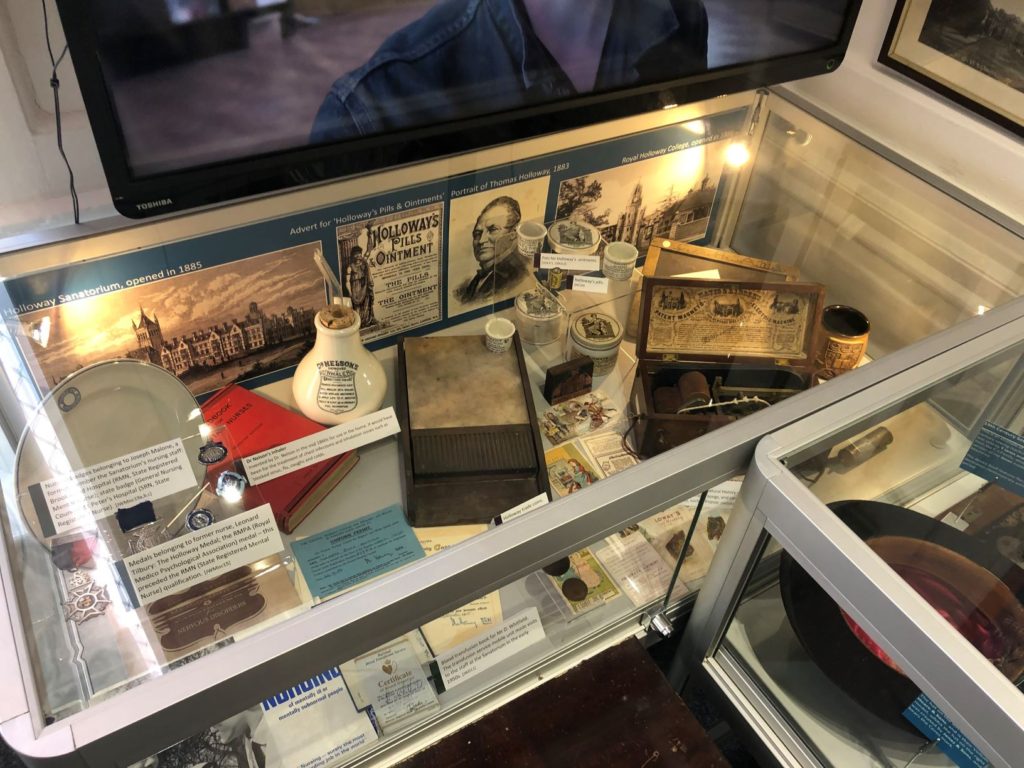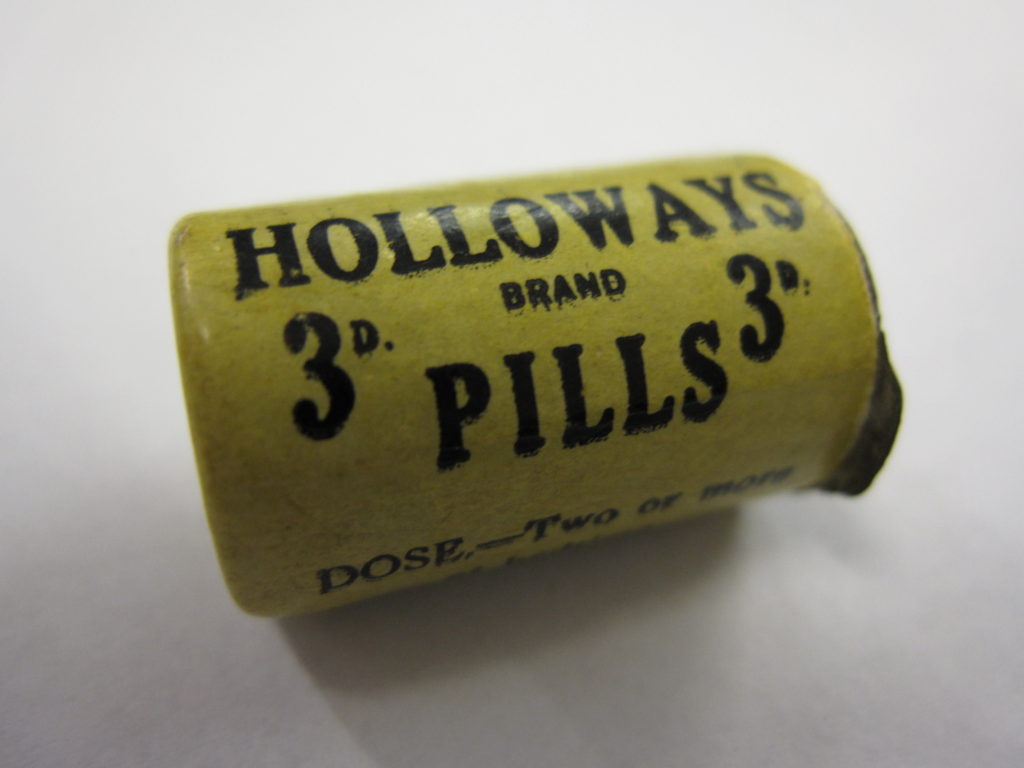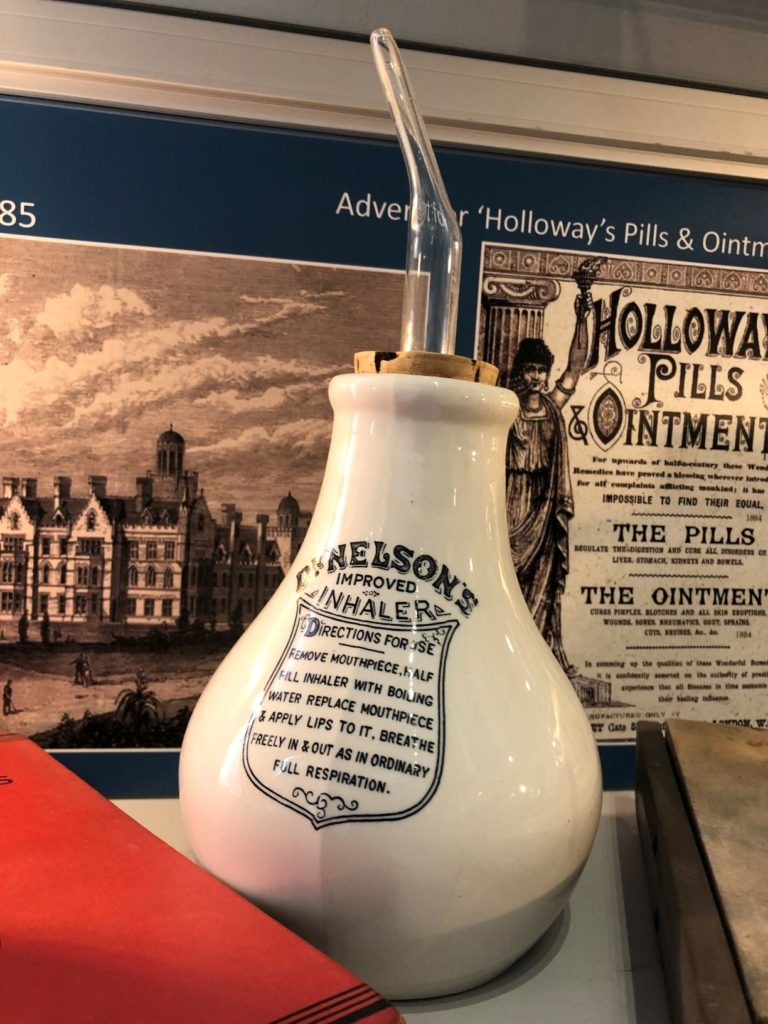Behind the Glass: Victorian Egham Part One
The Egham Museum tells the story of Egham, Egham Hythe, Englefield Green, Thorpe and Virginia Water from pre-history to the present day.
We’ve divided these stories into six sections.
Pre-Historic Egham
Medieval Egham
Georgian Egham
Victorian Egham
Egham at War
Post-Way Egham
Our Behind the Glass series gives you a tour of the items in the cases, you can see them all together in our Museum Tour video below.
Victorian Egham Part 1
The 19th century was a time of huge change in Great Britain and the industrial revolution changed the landscape and the lives of inhabitants forever.
One of the century’s great entrepreneurs was ‘Professor’ Thomas Holloway. With his patented ‘cure all’ medicines and flair for advertising, he created one of the world’s first global brands, “Holloway’s Pills and Ointments.” The self-made millionaire was generous with his good fortune, founding Holloway Sanatorium at Virginia Water in 1885 and Holloway College in Egham in 1886.
Thomas was born in Cornwall in 1800. After leaving school, Thomas helped his father run a pub and assisted his mother in a grocer’s shop. Ambitious and aware of the limitations in Cornwall, where the family had now settled, he left home in 1828. He met ointment salesman Felix Albinoloin 1837 and was inspired by his work. Adverts for Holloway’s ointments appeared shortly after and he worked with his wife Jane to grow the business.
Holloway’s genius lay not in the curative treatment of his pills and ointments, but in his grasp of modern advertising. ‘Holloway’s Pills and Ointments’ were one of the first truly global brands, with Thomas’s advertising budget at £1,000 in 1838, rising to £30,000 in 1855, and up to a staggering £50,000 in 1883 (approximately £3,310,000 in today’s money). In addition to his newspaper advertisements, Holloway’s pills and ointments were promoted on the sides of trams, through collectible cards and on trade tokens. Hoardings showing his adverts even appeared at Niagara Falls and the foot of the Great Pyramids at Giza.
You can find out more about Thomas Holloway and his legacy in our online exhibition “Health, Holloway and Hype”.
As well as Holloway Sanatorium in Virginia Water, Holloway used his fortune to build a university for the education of women, at the suggestion of his wife, Jane. Royal Holloway was opened in 1886 by Queen Victoria. Education at an organisation like this was only accessible to women whose families could financially support them. Prominent Suffragette Emily Wilding Davison who died in 1913 after stepping in front of the King’s horse at Epsom Derby had been a student at Royal Holloway College but had been forced to leave after the death of her father.
This is not Egham’s only connection to the suffrage movement.
Formed in 1897, Egham had two branches of the National Union of Women’s Suffrage Societies (NUWSS). The NUWSS believed in using law-abiding, non-violent methods to secure the vote for women. With the formation of the Women’s Social and Political Union (WSPU) in 1903 came violent attacks. In 1913, a house in Englefield Green was set on fire in the name of the cause.
National blood transfusion service paperwork (JW DOC 11) belonging to Dudley Whitfield. The transfusion service mobile unit made visits to the staff at the Sanatorium in the early 1950s to enable them to donate blood.
Two medals (JW MISC 15) belonging to L Tilbury, a nurse Holloway Sanatorium, 1935-75: The Holloway Medal; the RMPA (Royal Medico Psychological Association) medal – this preceded the RMN (State Registered Mental Nurse) qualification.
Brookwood Hospital Training School badge (JW MISC 19a) belonging to Joseph Malone.
The General Nursing Council badge (JW MISC 19b) belonging to Joseph Malone.
St Peter’s Hospital Training School badge (JW MISC 19c) belonging to Joseph Malone.
Certificate for general nursing council (JW DOC 187). Admit E J Whitfield to the register (number 27703) and her uniform permit for qualified nurses.
“Handbook for mental nurses”
Psychiatric nursing booklet (JW DOC 227)
Dr Nelson’s inhaler – Invented by Dr Nelson in the mid 1860s for use in the home. It would have been for the treatment of chest infections and inhalation issues such as blocked sinus, flu, coughs and colds.
Thomas Holloway Trade Tokens (MC1166) 1858 and 1857 penny and 1858 half penny.
Holloway’s ointment printing block
Holloway Trade Cards (JW DOC 262)
Holloway Pill Box (MC24) “Holloways Pills 3d, Dosage 2 or more at bedtime”
Holloway’s Ointment Pot (CER371)
Holloway’s Ointment Pot (CER312), containing cream contents.
Cross and Herbert pillboard (MC903), dated 1853. Used at Herbert’s the Chemist which was located on the High Street in different premises between 1899 and 1992.
Shocking Coil (MC417), Davis and Kidders “Patent Magneto Electric Machine for Nervous Diseases”.
Booklet (JW DOC 310a), ‘Holloway Sanatorium for Nervous Disorders’, promoting Holloway Sanatorium to nurses and showing facilities.
Plate (CER69c) from Holloway Sanatorium
Wooden framed school slate (MC333), dated aproximately 1930-1950, similar to those that would have been used during the victorian period.
Royal Holloway College Mug (CER425)
Royal Holloway College Milk Jug (CER462)





